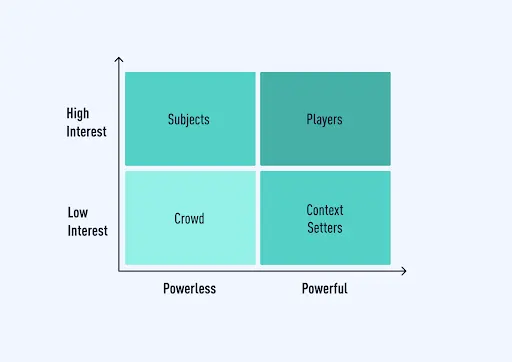The concept of stakeholder management was not born at the same time as product management: in fact, it’s probably been around for as long as social relationships have existed.
Product management is far from being the only discipline that recognizes the importance of being influential. The tech industry, however, has for a very long time placed prime importance on hard skills (such as programming) over softer skills. That might go a long way to explain why it’s taken some time for product management to formally recognize this particular skill.
So what exactly is stakeholder management? In this guide you’ll learn how the process works, as well as the three stages involved in carrying it out successfully.
If you’d like to skip ahead to a certain section, simply use the clickable menu:
- What is stakeholder management?
- What is a stakeholder management plan?
- What are the 3 stages of stakeholder management?
- What is the power-interest grid?
1. What is stakeholder management?
Simply put, stakeholder management is the process of identifying, prioritizing, and involving stakeholders in your work. As you can see, this is a concept which can be applied to a myriad of occupations, not just product management.
One of the most well-known proponents of stakeholder management as a business skill was Dale Carnegie. His bestselling book, How to Make Friends and Influence People, might be familiar to you: it’s considered one of the most popular books of all time. It also regularly comes up on the lists of recommended books for PMs, even though it’s not specifically about product management.
Why stakeholder management is important to PMs
The importance of stakeholder management for a product manager should not be underrated, nor considered a second-rate soft skill.
When properly leveraged, stakeholder management has the potential to clear blockers and ensure a PM is able to access the help they need from their various counterparts at the right time.
Conversely, poor stakeholder management may mean that a PM’s time and energy is being spent with infighting, as opposed to building value.
Think about this in very practical terms: a product manager is typically short on at least one of the following: time, money, or resources.
Having the right kind of connection and influence throughout an organization might be the difference between being able to build something or finding that your product priorities are not resonating throughout the organization and have therefore been de-prioritized.
2. What is a stakeholder management plan?
A stakeholder management plan is both a strategy and a commitment to leveraging and optimizing the relationship with the key people at your work.
While this may sound extremely business-like, it boils down to deciding to get to know your organization better, to foster a better relationship with a few key people within it and to do so in an organized, traceable way. So, how exactly can this be achieved in practice?

3. What are the three stages of stakeholder management?
If you find yourself going through the process of evaluating your stakeholders, proceeding in stages can be quite helpful. Let’s see how this might work in practice.
Stage One: Identifying key stakeholders
Before you decide how to approach your key stakeholders, you need to be able to identify them. If you’re stepping into a PM position for the first time, or if you’re about to switch companies, then it would be to your advantage to use the opportunity to learn firsthand how to identify the key people.
Remember that it’s one thing to learn by heart the different roles and titles within a company; it’s another to understand who really gets the job done, who has influence, who controls the purse strings, and who might be able to make your job as a PM easier or harder.
Pro tip: Start with a basic list of all departments you liaise with on a daily, weekly, monthly, and quarterly basis. Then add the names of all the people you interact with in each department.
Stage Two: Understanding stakeholders
After concluding with the identification, the next step in this analysis is to gain a better understanding of their goals and pain points. These two will almost inevitably inform how they perceive the product function and, by extension, your own work.
Depending on the type of organization you belong to, you may encounter stakeholders who are extremely knowledgeable about a product (perhaps they are former PMs themselves!), or, at the opposite end of the scale, stakeholders who have no idea what product management is about.
Pro tip: If your organization has implemented the use of metrics at departmental level, it’s very useful to consider how the work of your stakeholders is being measured. In all likelihood, this is where most of their efforts and concerns will be focussed.
Stage Three: Stakeholder prioritization
Armed with the information you’ve just gathered about your stakeholders, the time has now come to evaluate and classify them.
While continuous and active listening to one’s stakeholders is highly encouraged, the fact of the matter is that different people will want different things from a PM. Knowing how to say “No” is a key product management skill in and of itself, but equally as important is to know what to say “Yes” to. You need a backlog and a prioritization framework for your “No”s and “Yes”s, and that’s what we’ll look into next.
4. What is the power-interest grid?
After going through the step-by-step process of identifying and prioritizing your stakeholders, it helps to visualize the results in a framework or model. One of the most common ones is the power-interest grid.
The power-interest grid model operates along two different axes. It assumes that the two key dimensions of stakeholder management are Interest and Power.
Depending on how you assess each of your stakeholders across these two dimensions, they’ll fall into a specific quadrant, with some distinctive baseline approaches suggested:

Subjects
Stakeholders with an invested interest in the product, but holding comparatively little power. These could be individual contributors in key departments who neither manage others nor can be considered key decision-makers. Examples might include motivated customer success managers, or tech-savvy sales executives.
Tips: Keep them satisfied. Listen to their worries, hopes, and dreams. Make them feel involved. Don’t commit to building something simply because they ask you to.
Crowd
This isn’t an anonymous crowd—these are your colleagues. They are numerous and may know very little about your specific product. Examples may include people you hardly ever work or have meetings with, but who are a part of the organization.
Tips: Monitor. The strength of crowd members is in their numbers. You can probably afford to ignore isolated cases of dissatisfaction, but pay attention if organized forces of opposition arise.
Context Setters
Potential game-changers. They have considerable power, but helping the PM is not their top priority.
They might be PMs in charge of other products, extremely technical developers, or top-notch data analysts. Either way, they have a skillset complementary to yours.
Tips: Keep Informed. Practice active listening. Learn from them whenever possible.
Players
This is your make-or-break stakeholder quadrant. The stakeholders positioned here might have the ability to shut your product down. They might also give you all the resources you long for.
Relevant examples would be people whose job title starts with a “C”, like CEO, COO, CPO, so on and so forth. With these you have to be wary of things like executive Shiny Object Syndrome, a fun-sounding but potentially critical threat to the product.
Tips: Engage and consult. Thread carefully. Look for mutually beneficial trade-offs. Evangelize, lobby them as much as is necessary.
5. Wrap up
One of the few certainties in the life of a product manager is that as long as you remain a PM, you’ll have stakeholders to deal with. Stakeholders have the power to make your own work considerably easy or unbearably harder, so the art of stakeholder management is crucial.
Stakeholder management is an essential product management skill to pick up if you’re starting a career in the field, which is why it’s a key part of the CareerFoundry Product Management Program. If you’re not 100% sure yet whether this is the path for you, why not try a free introductory product management short course to start your practical learning in this exciting career area.
Looking to deepen your knowledge of product management? Be sure to check out the following articles:
